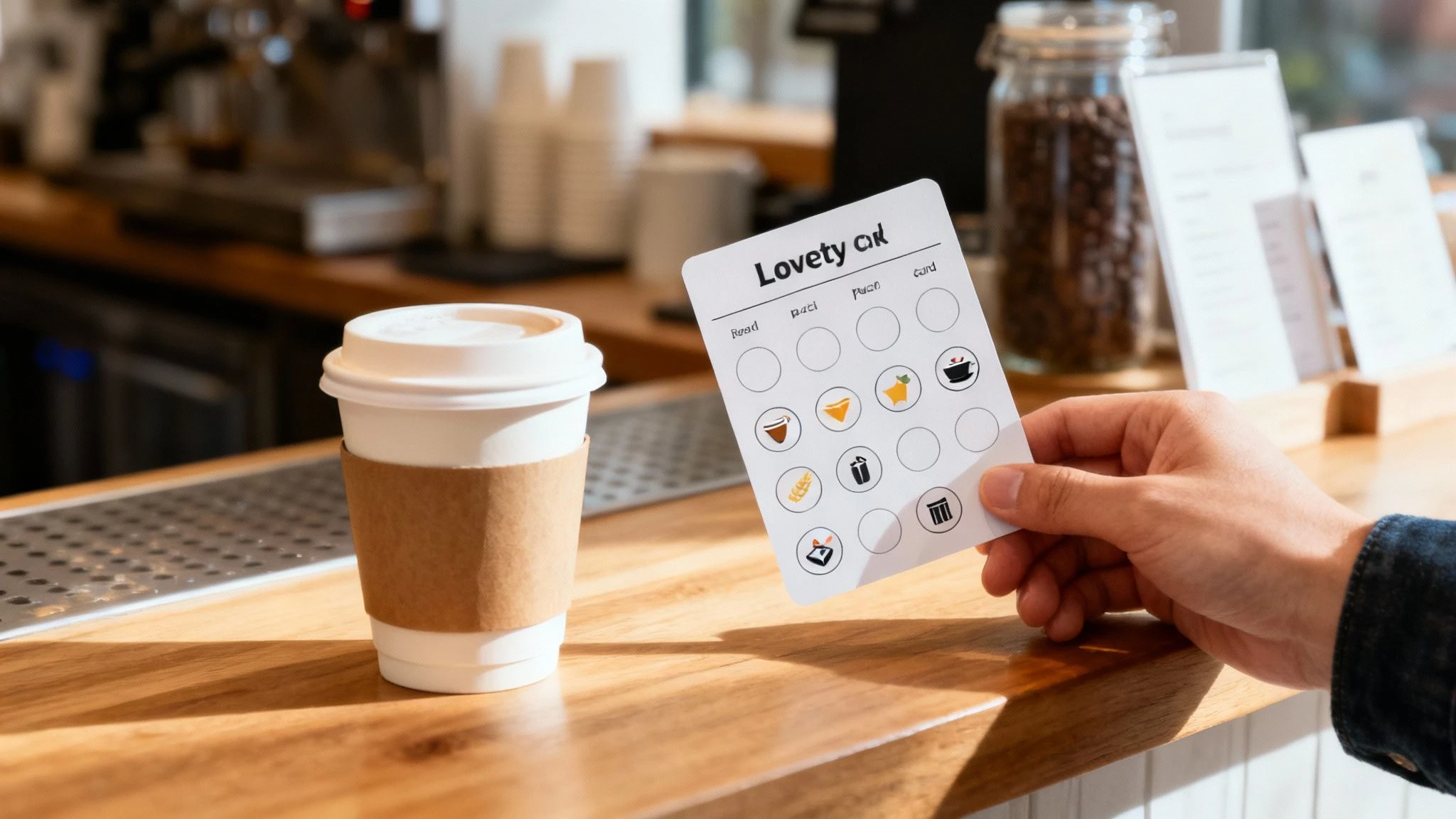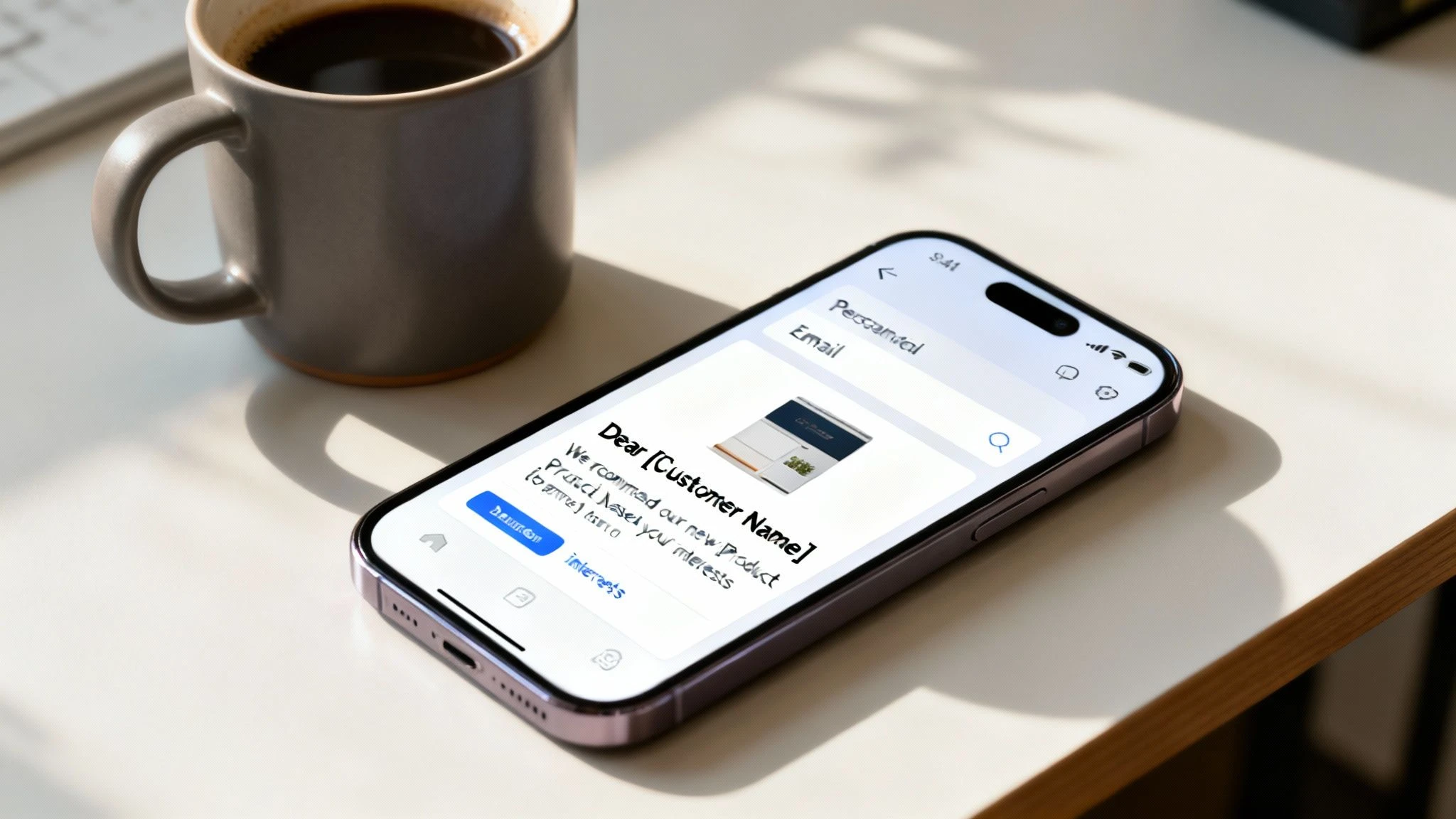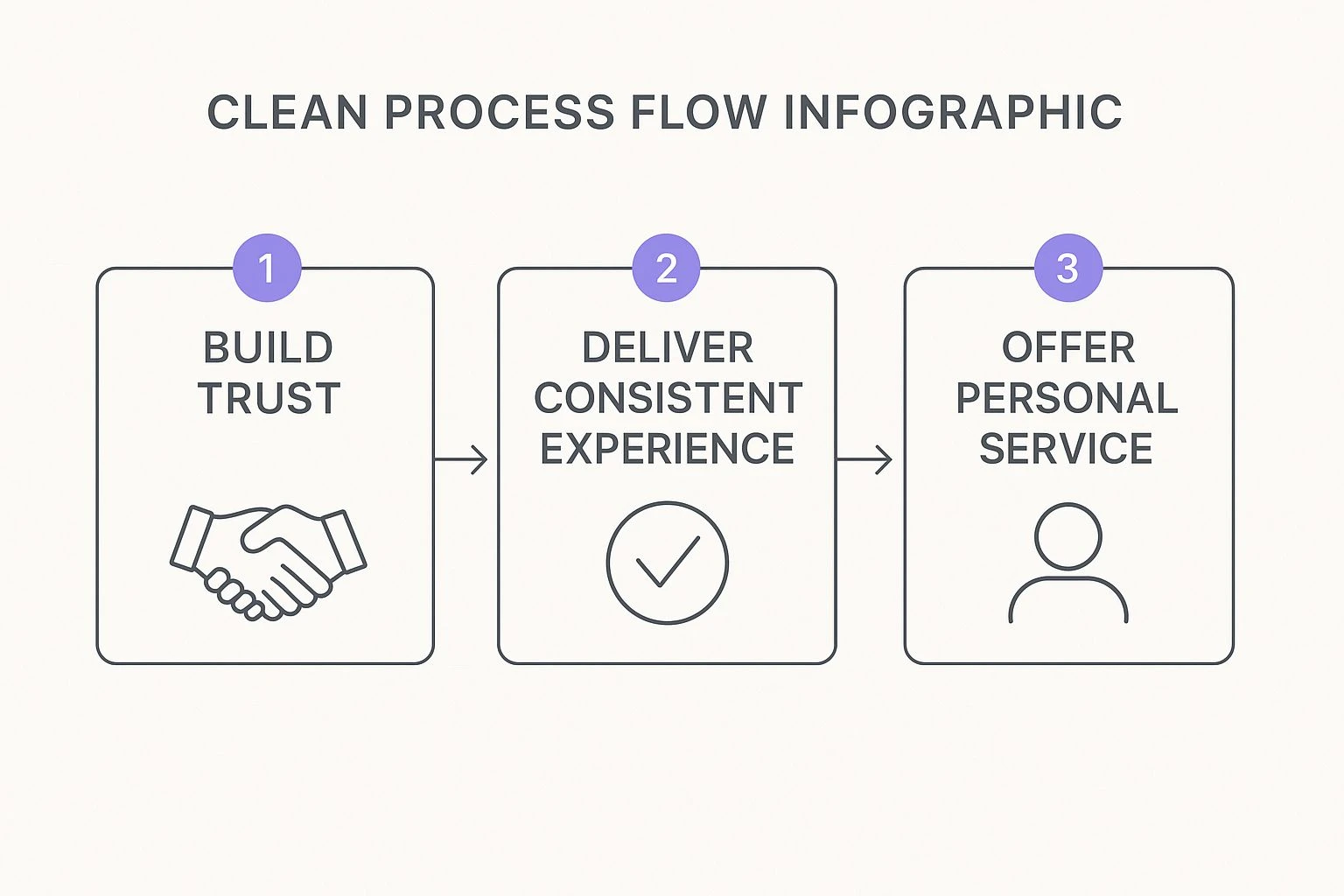When you think about customer loyalty, it's easy to get stuck on repeat purchases. But real loyalty goes so much deeper than that. It's about building a genuine connection that turns casual shoppers into die-hard fans of your brand.
This connection isn't built overnight. It comes from earning their unwavering trust, delivering consistent experiences, and offering service that feels personal and valued. Get that right, and you’ll have a customer base that sticks with you, even when a cheaper or faster option comes along.
Why Customer Loyalty Is Your Secret Weapon
Let's toss out the old idea that loyalty is just about transactions. It’s about creating a relationship where your customers feel seen, understood, and genuinely appreciated.
When people feel that connection, they don’t just buy from you-they become your biggest advocates. This isn't just a warm and fuzzy idea; it's a rock-solid business strategy, especially now that finding new customers is tougher and more expensive than ever.
The numbers don't lie. Customer acquisition costs have jumped by nearly 60% in the last five years. For many businesses, that means losing an average of $29 for every new customer they bring in. This puts a ton of pressure on brands to focus on the customers they already have.
The Core Ingredients of Lasting Loyalty
So, how do you actually build this powerful bond? It really comes down to three key pillars that work together to create an experience that keeps people coming back for more.
- Unwavering Trust: Your customers need to believe you'll deliver on your promises. You build this through honesty, reliability, and consistently great products or services. No shortcuts.
- Consistent Experiences: Every single interaction has to feel familiar and positive, whether they're scrolling your website or talking to your support team. Consistency builds comfort and confidence.
- Personal Service: Make your customers feel like individuals, not just order numbers. It can be as simple as remembering a past purchase or as thoughtful as sending a personalized recommendation. It shows you're paying attention.
This visual breaks down the process perfectly.
As you can see, loyalty isn't a one-and-done deal. It's a deliberate cycle of actions, starting with trust and leading to genuine, personalized engagement. If you want to go deeper, check out our complete guide on the fundamentals of customer loyalty.
Designing a Loyalty Program People Actually Use

Let's be real: a great loyalty program isn't just another plastic card in a wallet or a forgotten app on a phone. It's an experience. It should feel like an exclusive club that your customers are genuinely excited to join and, more importantly, use.
The secret isn't copying what the big-box stores are doing. A local coffee shop’s simple punch card and a software company’s tiered access system are both loyalty programs at their core. But they work because they’re built for completely different customers with different motivations. You have to match the structure and the rewards to your specific business and the people you serve.
And the demand is definitely there. The global loyalty management market was valued at a staggering $13.31 billion and is expected to hit $41.21 billion by 2032. With 80% of American consumers already part of at least one program, people are clearly looking for reasons to stick around. Your job is to give them a compelling one. You can find more of the latest loyalty market research over on Antavo.com.
Choosing the Right Program Model
Before you start dreaming up cool rewards, you need a framework. The structure of your program sets the rules of the game for your customers. Picking the right one depends entirely on how people buy from you.
To make this easier, let's break down the most common models. Think of this table as your starting point for figuring out what makes the most sense for your business, your budget, and your customers.
Comparing Loyalty Program Models for Small Businesses
| Program Type | How It Works | Best For | Potential Drawback |
|---|---|---|---|
| Points-Based | Customers earn points for purchases (e.g., $1 = 1 point) and redeem them for rewards. | Businesses with frequent, smaller transactions, like cafes, bakeries, or quick-service restaurants. | Can feel generic if the rewards aren't exciting. Customers might lose track of points. |
| Tiered Program | Customers unlock new levels of perks as their spending or engagement increases (e.g., Silver, Gold, Platinum). | Brands wanting to build aspiration and reward top spenders, like fashion boutiques, salons, or B2B services. | Lower tiers might not feel valuable enough to motivate customers to climb the ladder. |
| Paid (VIP) Program | Customers pay a recurring fee (monthly or annually) for instant access to premium, ongoing benefits. | Businesses that can offer significant, continuous value, like subscription services, e-commerce stores with free shipping, or membership clubs. | The upfront cost can be a barrier for some customers. The benefits have to be really good. |
Ultimately, the best model is the one that feels natural for your business. A points system is beautifully simple for a business built on daily habits, while a tiered program adds a touch of gamification that can turn casual buyers into true brand advocates.
Crafting Rewards That Actually Motivate
The rewards are the heart and soul of your program. If they’re boring or unattainable, nobody’s going to bother. The goal here is to offer something that feels incredibly valuable to your customer without tanking your profit margins.
The most effective rewards make customers feel like insiders. It's less about the monetary value and more about the perceived value of exclusivity, convenience, or recognition.
For example, a local bookstore could offer a free tote bag, which is nice. But offering early access to an author signing? That’s memorable and feels way more valuable to a true book lover. A B2B software company could offer a standard 10% discount, but a free one-on-one strategy session with an in-house expert provides a much higher perceived value and strengthens the relationship. If you want to dig deeper, there are some great ideas on how to create loyalty programs that customers love.
Think beyond just giving stuff away for free. Consider rewards that tap into emotion and experience:
- Experiential Perks: Exclusive access to workshops, behind-the-scenes tours, or members-only events.
- Convenience: Things like free shipping, priority service, or a dedicated support line make life easier.
- Recognition: A simple "customer of the month" shout-out on social media can go a long way.
- Partner Rewards: Team up with a complementary local business to offer a unique joint reward that benefits everyone.
When you focus on a structure that fits your business and rewards that provide genuine, aspirational value, you’re not just encouraging repeat business. You're building a deeper, more meaningful connection with the people who support you.
To make sure you're on the right track from the start, check out our guide on the 6 golden rules for setting up a successful loyalty program with points.
Connecting Loyalty to Your Bottom Line

Making customers feel special is great, but let’s talk about what really matters: how does it actually hit your bank account? The link between a happy, loyal customer and a healthy bottom line isn't just a nice idea-it's a measurable reality that can make or break your business's growth.
Think of your loyal customers as your most valuable asset. They don’t just make repeat purchases. They consistently spend more each time they visit and are far less likely to get lured away by a competitor's flashy discount.
This is where they transform from simple buyers into your most powerful, organic marketing force. Their word-of-mouth recommendations carry more weight and credibility than almost any paid ad you could ever run.
The Financial Impact of Retention
The data tells a pretty compelling story. A modest 5% increase in customer retention can crank up your profits by a staggering 25% to 95%. It’s a huge number. Yet, many businesses still struggle to bridge the gap between keeping customers happy and actually earning their long-term loyalty.
So, where does that profit boost come from? It boils down to a few key things:
- Higher Average Order Value (AOV): Repeat customers already trust your quality. That makes them way more willing to try new products or spring for the premium options.
- Increased Purchase Frequency: When you become part of their routine, they come back more often. More visits mean more sales.
- Reduced Marketing Costs: This one’s a no-brainer. It is always, always cheaper to keep an existing customer than it is to chase down a new one.
The real magic of loyalty isn’t just in locking down the next sale. It's in the total revenue a customer brings over their entire relationship with your brand. That number is a direct reflection of how well you're doing.
Tracking the Metrics That Matter
To actually see these results for yourself, you have to track the right data. It all starts with understanding your Customer Lifetime Value (CLTV), which is basically the total amount of money you can expect to make from a single customer over time.
But CLTV is just the beginning. You'll want to keep an eye on a few other key performance indicators (KPIs) to get the full picture of your program's financial health. Watching these numbers gives you the concrete proof you need to justify-and fine-tune-your investment in building these crucial relationships. If you want to dive deeper into what to track, we've got a great guide on loyalty program analytics and stats you can check out.
By tying these hard numbers to your loyalty efforts, you stop hoping customers will come back and start building a predictable, data-driven engine for real, sustainable growth.
Making Personalization Feel Human

Personalization is one of the most powerful tools in your loyalty toolkit, but so many businesses get it wrong. It’s not about dropping [First Name] into a generic email and calling it a day. Real personalization is about using what you know to make your customers feel seen, understood, and genuinely appreciated.
When you get this right, you show people you’re paying attention to them as individuals, not just as numbers in a spreadsheet. It’s the difference between a transactional relationship and a loyal one.
Group Customers for Smarter Communication
You don't need a team of data scientists to start personalizing your communication. One of the simplest yet most effective methods is customer segmentation. All this means is grouping customers together based on what they have in common.
Think about a local coffee shop. They could easily create segments like:
- Morning Rush Regulars: The folks who grab a coffee every weekday between 7 and 9 AM.
- Weekend Treat Seekers: Customers who pop in on Saturdays for pastries and specialty lattes.
- New Visitors: Anyone who's only made one purchase in the last month.
Once you have these simple groups, you can send them messages they'll actually want to read. The "Morning Rush" crew might get a text about a new breakfast sandwich, while the "Weekend Treat" crowd gets an email showcasing a seasonal pumpkin spice creation. It’s relevant, timely, and way more effective.
Celebrate Milestones That Matter
Another great way to build a human connection is to acknowledge important moments in a customer's journey with your brand. These milestones are the perfect excuse to reach out and remind them that you value their business.
And I'm not just talking about birthdays. Think about setting up simple, automated messages for occasions like:
- First Purchase Anniversary: A quick "Thanks for being with us for a year!" note with a small discount code goes a long way.
- Loyalty Program Anniversaries: Celebrate the day they officially joined your community.
- Reaching a Spending Threshold: Acknowledge when a customer becomes one of your top spenders and make them feel like a VIP.
It’s not always the size of the discount that matters; it's the act of remembering. Acknowledging these small moments reinforces that your relationship is more than just transactional.
This simple act of recognition makes customers feel valued, strengthening their emotional connection to your business and giving them one more reason to stick around.
Use Purchase History to Guide Recommendations
One of the most direct ways to prove you get your customers is by offering smart recommendations based on what they've bought before. This shows you’re not just trying to push random products-you're genuinely trying to help them discover more of what they already love.
For example, if a customer at your pet store consistently buys a specific brand of grain-free dog food, sending them a heads-up when a new flavor from that same brand arrives is incredibly useful. It's a world away from a generic "new products" newsletter.
Most modern CRM or email marketing tools let you set up these kinds of automated triggers based on purchase history. These thoughtful little touches are what transform a generic marketing blast into a helpful piece of communication, which is the secret sauce to building customer loyalty that actually lasts.
Getting the Word Out About Your Loyalty Program
You’ve put in the work and designed a fantastic loyalty program. That’s the hard part, right? Well, not quite. A brilliant program is completely useless if nobody knows it exists.
A strong launch isn't just a single announcement-it's a full-on campaign designed to build excitement and get people signing up on day one. Your goal is to make joining feel like a no-brainer, an unmissable opportunity they'll regret passing up.
Don't just send one email and cross your fingers. You need to plan a multi-channel blitz that catches your customers wherever they are. This initial push is what builds the momentum you need for the long haul.
Creating a Powerful Launch Strategy
Your launch day should feel like a genuine event. The trick is to combine your digital marketing with what’s happening in-store to create a buzz that’s impossible to ignore. Every email, post, and sign should be dripping with clarity and enthusiasm.
Email Marketing Blast: Write an email that gets straight to the good stuff-the benefits. Don't just list the rules; tell a quick story about the exclusive perks they're about to unlock. A strong call-to-action is key here. Think something like, "Join the Club & Get Your First Reward Now!"
Social Media Campaign: Start teasing the program a few days before you go live. Use eye-catching graphics or short, snappy videos to show people how it works. On launch day, make your posts shareable. A great way to do this is by offering a special sign-up bonus for anyone who joins in the first 24 hours.
In-Store Promotion: Your physical location is your secret weapon. Train your team to be your program's biggest cheerleaders. Give them a simple script to explain the benefits and get people signed up right at the point of sale. You'd be amazed how effective a few simple signs at the checkout counter can be.
This first wave of promotion is how you start building customer loyalty from the get-go. By making a big splash, you're showing customers this program isn't an afterthought-it's a core part of their experience with you.
Keeping the Momentum Going
Alright, launch day was a success. Now what? The work doesn’t stop there. Consistent, ongoing communication is what keeps a loyalty program from fizzling out. If you "set it and forget it," your members will, too.
Think of your program as an ongoing conversation. Every so often, you need to remind members about the value they're getting and give them a little nudge toward their next reward. This keeps the program top-of-mind and encourages them to keep participating.
A loyalty program's biggest enemy is silence. Regular, relevant communication reinforces the program's value and prevents it from fading into the background of a customer's busy life.
Here are a few simple ways to keep the engagement high:
Automated Reward Reminders: Set up an automated email to go out when a customer is just a purchase or two away from their next reward. A little nudge like, "You're so close!" can be an incredibly powerful motivator.
Exclusive Member Updates: Make your members feel like insiders. Send them special content, early access to sales, or a sneak peek at new products. This reinforces the idea that the program offers way more than just discounts.
Monthly Point Summaries: A simple monthly email showing members their current point balance and the rewards they can claim is all it takes. It keeps them in the loop and invested in earning that next perk.
By consistently talking about the benefits and keeping the rules simple, you turn a basic program into a seriously powerful tool for keeping your best customers around.
Alright, you’ve got the big picture on loyalty. But when it's time to actually build something, the practical questions start popping up. How much is this going to cost? How do I even know if it's working?
Let's get straight to it. Here are the no-fluff answers to the questions we hear most from small business owners trying to figure this all out.
How Much Does a Customer Loyalty Program Cost?
This is the big one, and the good news is, the answer can be "almost nothing" or "a few hundred a month." It all depends on what you need.
A simple, old-school punch card can cost you next to nothing-just the price of printing. For a coffee shop, a food truck, or a local bakery, these are classic for a reason. They work.
If you want to go digital, loyalty program software can range anywhere from $25 to over $300 a month. The price tag usually depends on the features you want, like how well it talks to your point-of-sale system, the level of automation, and how many customers you have. The trick is to start with a budget that makes sense for your business right now.
The goal isn't to find the cheapest option. It’s to pick a program where the return-in the form of happier, higher-spending customers-is a no-brainer compared to the monthly cost.
How Do I Measure the Success of My Program?
Success shouldn't be a gut feeling. It’s something you can-and absolutely should-measure with cold, hard numbers. Tracking a few key metrics will tell you exactly what kind of return you're getting on your loyalty efforts.
Here’s what you should be watching:
- Customer Retention Rate: Is this number going up after you launched the program? This is the most direct sign that you're building loyalty.
- Repeat Purchase Rate: This tells you how many of your customers are coming back for a second, third, or fourth time. It’s a dead-simple way to see if you're creating habits.
- Redemption Rate: Are people actually using the rewards they earn? If not, it could be a sign that your rewards aren't exciting enough to get them back in the door.
- Average Order Value (AOV): Put your loyalty members side-by-side with your non-members. Are the members spending more each time they visit? A great program encourages them to do just that.
What Are the Biggest Mistakes to Avoid?
Sometimes, knowing what not to do is just as critical as knowing what to do. Plenty of well-meaning loyalty programs fizzle out because of a few common, but totally avoidable, blunders.
One of the absolute biggest mistakes is making the program too complicated. If a customer has to pull out a calculator to figure out how to earn a reward, you've already lost. They'll just give up. Keep it simple.
Another classic error is offering rewards that nobody wants. A discount on a product your best customers never buy is completely pointless. Your rewards have to feel valuable and relevant to the people you want to keep.
And finally, don't just launch it and forget it. A lack of communication will kill your program's momentum. If you set up a great system but never remind people it exists, engagement will naturally die off. A friendly email, a quick mention at checkout-it all works to keep your program top of mind.
Ready to create a loyalty program your customers will actually love? With BonusQR, you can launch a simple, powerful, and affordable digital loyalty program in minutes. Start building lasting customer relationships today!
